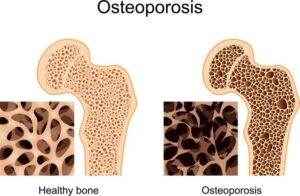Guest Blog: Post-Menopausal Women Likely To Develop Spine Fracture Due To Osteoporosis


Osteoporosis remains the most prominent factor for the onset of bone weakness and thereby causing spinal fractures and deformities with aging, it is important to ensure a healthy lifestyle at least from the age of 20 years. Even though with the availability of a plethora of treatment modules, fractured vertebrae result in severe back pain, loss of height or spinal deformities such as kyphosis (stooped posture), depleting the quality of life among the geriatric population.
While spinal fractures are the most common fractures caused due to osteoporosis, the long-term consequences can be devastating with acute and chronic debilitating pain, and changes in the spinal alignment post the fracture has healed. Other comorbidities include significant performance impairment in physical, functional and psychological domains in older women, decreased pulmonary function and increased risk of lung disorder.
Further there is an estimated fivefold risk of development of future spinal fracture after the first one. Thus, a bone density test is preferred especially for post-menopausal women which can predict the risk of future osteoporosis and hip fracture, which not only determined the rate of bone loss but also helpful in monitoring the effect of treatment thereby preventing a fracture before occurring.
“Balloon Kyphoplasty is a minimally invasive treatment that stabilized the fracture, thereby reducing pain and providing with correction of the deformity. A small balloon is guided through the instrument in to the vertebra. The incision size is approximately 1 cm in length. The balloon is carefully inflated in an attempt to raise the collapsed vertebra and return it to its normal position inflation of balloon creates a void (cavity) in the vertebral body. Once the vertebra is in the correct position the balloon is deflated and removed. The cavity is filled with bone cement forming an internal cast to support the surrounding bone and prevent further collapse. Generally, the procedure is done on both sides of the vertebral body” said Prof. (Col). Dr Bipin Walia, Senior Director & Head- Neurosurgery, Max Super Specialty Hospital, Saket, New Delhi
Osteoporosis is a disease characterized by low bone mass and structural deterioration of bone tissue leading to bone fragility and an increased susceptibility to fracture of hip, spine and wrist. The exact data for India is not available but it is estimated the over 20 crore Indians have abnormally low bone mass placing them at an increased risk of Osteoporosis. And approximately one in four patients dies within one year following an Osteoporotic hip fracture.
“Patient with painful spinal fracture have traditionally received palliative (Pain reducing) care, including bed rest, narcotic analgesics and external bracing. Severe pain caused by spinal fracture may require bed rest for up to six months. The balloon kyphoplasty procedure typically takes about one hour per fracture and may require an overnight hospital stay. Post operatively there is a significant improvement in the mobility including the ability to perform daily activities such as walking hobbies and work, and as many as 90% of the patients report a complete pain relief within 24 hours of the procedure.” He added
Building strong bones during childhood and adolescence may be the best defense against developing Osteoporosis. By about age of 20, the average woman that acquired 98% of her skeletal mass.
There are four steps to prevent Osteoporosis. No one step alone is enough to prevent the disease, but a combination of the following is recommended. A balanced diet rich in calcium (1200mg daily for men and women over 50) and vitamin D (between 400 and 600 IU daily). Besides this weight bearing exercises (any exercise in which your bones and muscles work against gravity), a healthy lifestyle with no smoking or excessive alcohol intake and bone density testing and medication are also recommended. There are medications which will be advised by the physician depending on the disease severity to treat the Osteoporosis.
About the author- Dr Bipin Walia, Senior Director & Head- Neurosurgery, Max Super Specialty Hospital, Saket, New Delhi
